Microfinance: History, Issues, and Case Study of Bandhan Bank
VerifiedAdded on 2022/11/16
|14
|4074
|324
AI Summary
This report discusses the history of microfinance, issues faced by banks and financial institutions in lending microfinance, and a case study of Bandhan Bank. It also provides recommendations to solve the issues.
Contribute Materials
Your contribution can guide someone’s learning journey. Share your
documents today.

Running head: MICROFINANCE
Microfinance
Name of the Student
Name of the University
Student ID
Microfinance
Name of the Student
Name of the University
Student ID
Secure Best Marks with AI Grader
Need help grading? Try our AI Grader for instant feedback on your assignments.
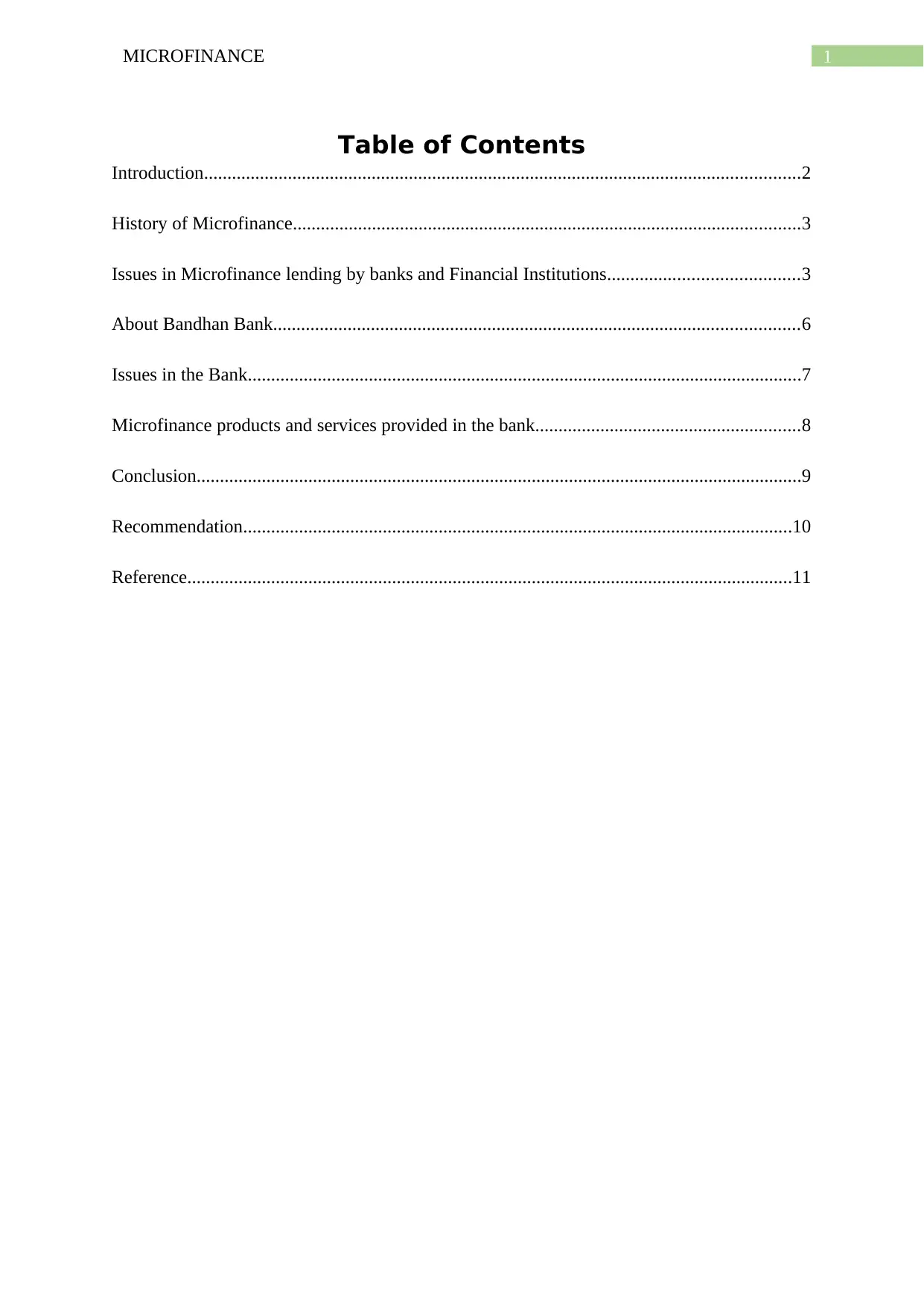
1MICROFINANCE
Table of Contents
Introduction................................................................................................................................2
History of Microfinance.............................................................................................................3
Issues in Microfinance lending by banks and Financial Institutions.........................................3
About Bandhan Bank.................................................................................................................6
Issues in the Bank.......................................................................................................................7
Microfinance products and services provided in the bank.........................................................8
Conclusion..................................................................................................................................9
Recommendation......................................................................................................................10
Reference..................................................................................................................................11
Table of Contents
Introduction................................................................................................................................2
History of Microfinance.............................................................................................................3
Issues in Microfinance lending by banks and Financial Institutions.........................................3
About Bandhan Bank.................................................................................................................6
Issues in the Bank.......................................................................................................................7
Microfinance products and services provided in the bank.........................................................8
Conclusion..................................................................................................................................9
Recommendation......................................................................................................................10
Reference..................................................................................................................................11
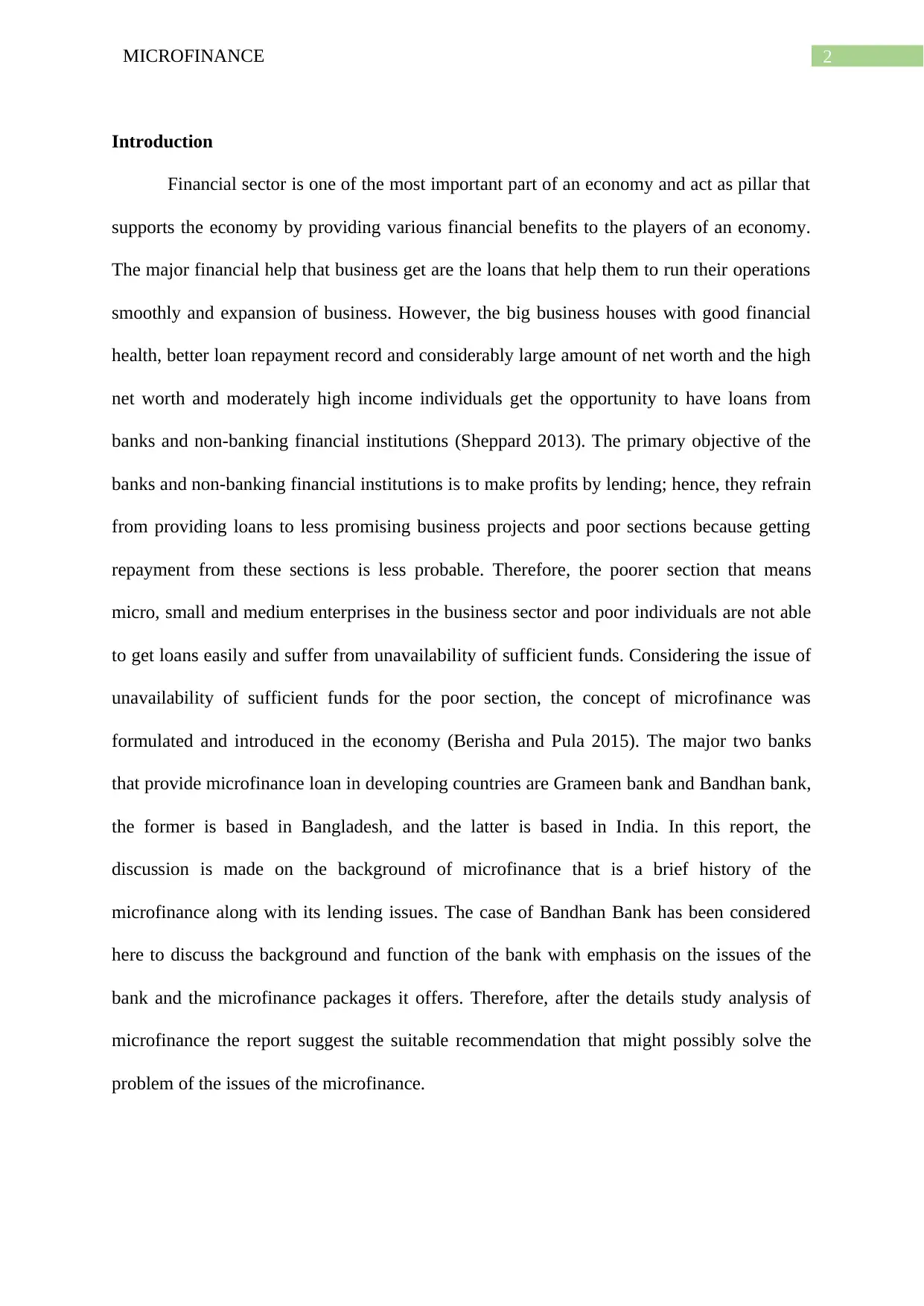
2MICROFINANCE
Introduction
Financial sector is one of the most important part of an economy and act as pillar that
supports the economy by providing various financial benefits to the players of an economy.
The major financial help that business get are the loans that help them to run their operations
smoothly and expansion of business. However, the big business houses with good financial
health, better loan repayment record and considerably large amount of net worth and the high
net worth and moderately high income individuals get the opportunity to have loans from
banks and non-banking financial institutions (Sheppard 2013). The primary objective of the
banks and non-banking financial institutions is to make profits by lending; hence, they refrain
from providing loans to less promising business projects and poor sections because getting
repayment from these sections is less probable. Therefore, the poorer section that means
micro, small and medium enterprises in the business sector and poor individuals are not able
to get loans easily and suffer from unavailability of sufficient funds. Considering the issue of
unavailability of sufficient funds for the poor section, the concept of microfinance was
formulated and introduced in the economy (Berisha and Pula 2015). The major two banks
that provide microfinance loan in developing countries are Grameen bank and Bandhan bank,
the former is based in Bangladesh, and the latter is based in India. In this report, the
discussion is made on the background of microfinance that is a brief history of the
microfinance along with its lending issues. The case of Bandhan Bank has been considered
here to discuss the background and function of the bank with emphasis on the issues of the
bank and the microfinance packages it offers. Therefore, after the details study analysis of
microfinance the report suggest the suitable recommendation that might possibly solve the
problem of the issues of the microfinance.
Introduction
Financial sector is one of the most important part of an economy and act as pillar that
supports the economy by providing various financial benefits to the players of an economy.
The major financial help that business get are the loans that help them to run their operations
smoothly and expansion of business. However, the big business houses with good financial
health, better loan repayment record and considerably large amount of net worth and the high
net worth and moderately high income individuals get the opportunity to have loans from
banks and non-banking financial institutions (Sheppard 2013). The primary objective of the
banks and non-banking financial institutions is to make profits by lending; hence, they refrain
from providing loans to less promising business projects and poor sections because getting
repayment from these sections is less probable. Therefore, the poorer section that means
micro, small and medium enterprises in the business sector and poor individuals are not able
to get loans easily and suffer from unavailability of sufficient funds. Considering the issue of
unavailability of sufficient funds for the poor section, the concept of microfinance was
formulated and introduced in the economy (Berisha and Pula 2015). The major two banks
that provide microfinance loan in developing countries are Grameen bank and Bandhan bank,
the former is based in Bangladesh, and the latter is based in India. In this report, the
discussion is made on the background of microfinance that is a brief history of the
microfinance along with its lending issues. The case of Bandhan Bank has been considered
here to discuss the background and function of the bank with emphasis on the issues of the
bank and the microfinance packages it offers. Therefore, after the details study analysis of
microfinance the report suggest the suitable recommendation that might possibly solve the
problem of the issues of the microfinance.
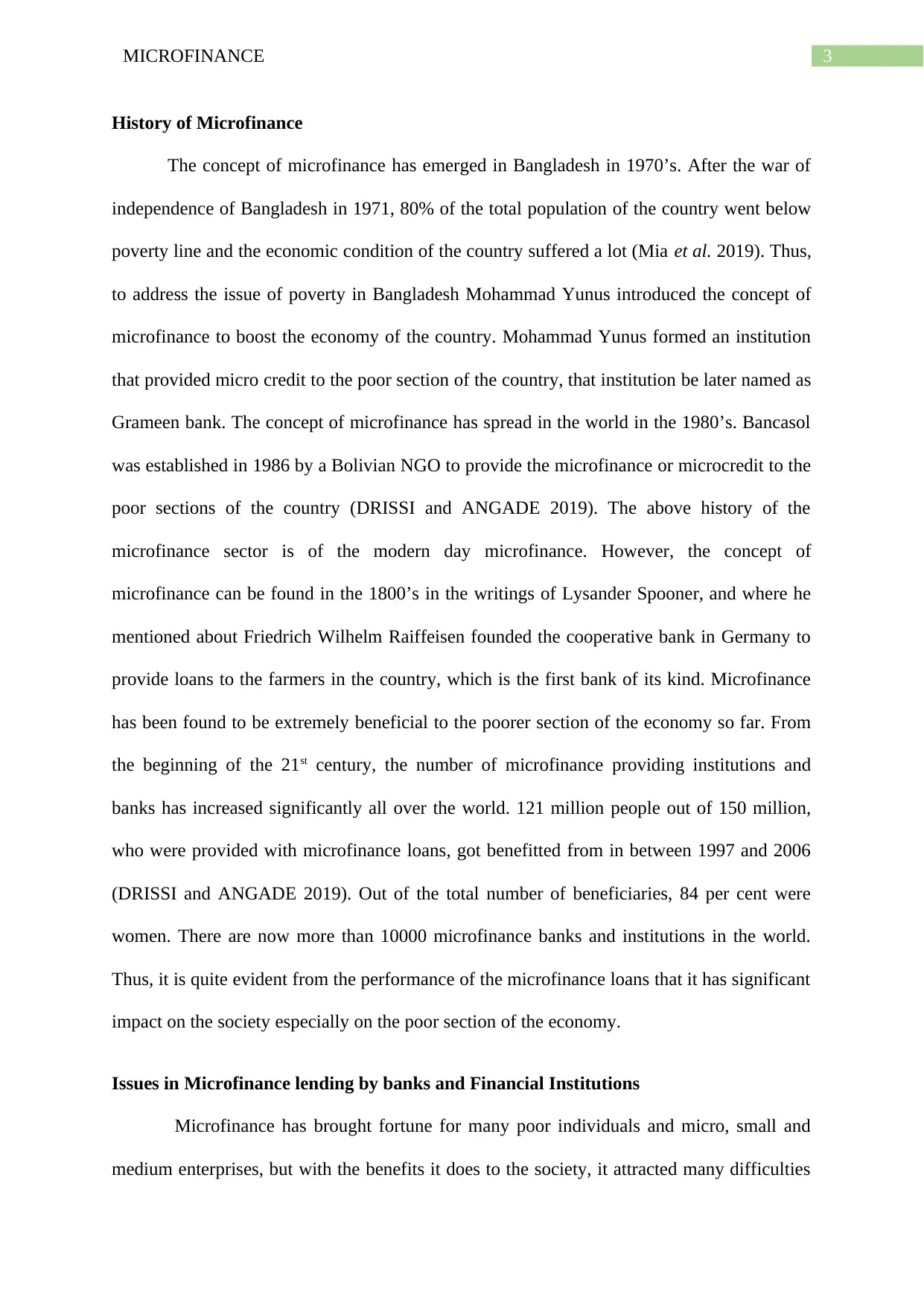
3MICROFINANCE
History of Microfinance
The concept of microfinance has emerged in Bangladesh in 1970’s. After the war of
independence of Bangladesh in 1971, 80% of the total population of the country went below
poverty line and the economic condition of the country suffered a lot (Mia et al. 2019). Thus,
to address the issue of poverty in Bangladesh Mohammad Yunus introduced the concept of
microfinance to boost the economy of the country. Mohammad Yunus formed an institution
that provided micro credit to the poor section of the country, that institution be later named as
Grameen bank. The concept of microfinance has spread in the world in the 1980’s. Bancasol
was established in 1986 by a Bolivian NGO to provide the microfinance or microcredit to the
poor sections of the country (DRISSI and ANGADE 2019). The above history of the
microfinance sector is of the modern day microfinance. However, the concept of
microfinance can be found in the 1800’s in the writings of Lysander Spooner, and where he
mentioned about Friedrich Wilhelm Raiffeisen founded the cooperative bank in Germany to
provide loans to the farmers in the country, which is the first bank of its kind. Microfinance
has been found to be extremely beneficial to the poorer section of the economy so far. From
the beginning of the 21st century, the number of microfinance providing institutions and
banks has increased significantly all over the world. 121 million people out of 150 million,
who were provided with microfinance loans, got benefitted from in between 1997 and 2006
(DRISSI and ANGADE 2019). Out of the total number of beneficiaries, 84 per cent were
women. There are now more than 10000 microfinance banks and institutions in the world.
Thus, it is quite evident from the performance of the microfinance loans that it has significant
impact on the society especially on the poor section of the economy.
Issues in Microfinance lending by banks and Financial Institutions
Microfinance has brought fortune for many poor individuals and micro, small and
medium enterprises, but with the benefits it does to the society, it attracted many difficulties
History of Microfinance
The concept of microfinance has emerged in Bangladesh in 1970’s. After the war of
independence of Bangladesh in 1971, 80% of the total population of the country went below
poverty line and the economic condition of the country suffered a lot (Mia et al. 2019). Thus,
to address the issue of poverty in Bangladesh Mohammad Yunus introduced the concept of
microfinance to boost the economy of the country. Mohammad Yunus formed an institution
that provided micro credit to the poor section of the country, that institution be later named as
Grameen bank. The concept of microfinance has spread in the world in the 1980’s. Bancasol
was established in 1986 by a Bolivian NGO to provide the microfinance or microcredit to the
poor sections of the country (DRISSI and ANGADE 2019). The above history of the
microfinance sector is of the modern day microfinance. However, the concept of
microfinance can be found in the 1800’s in the writings of Lysander Spooner, and where he
mentioned about Friedrich Wilhelm Raiffeisen founded the cooperative bank in Germany to
provide loans to the farmers in the country, which is the first bank of its kind. Microfinance
has been found to be extremely beneficial to the poorer section of the economy so far. From
the beginning of the 21st century, the number of microfinance providing institutions and
banks has increased significantly all over the world. 121 million people out of 150 million,
who were provided with microfinance loans, got benefitted from in between 1997 and 2006
(DRISSI and ANGADE 2019). Out of the total number of beneficiaries, 84 per cent were
women. There are now more than 10000 microfinance banks and institutions in the world.
Thus, it is quite evident from the performance of the microfinance loans that it has significant
impact on the society especially on the poor section of the economy.
Issues in Microfinance lending by banks and Financial Institutions
Microfinance has brought fortune for many poor individuals and micro, small and
medium enterprises, but with the benefits it does to the society, it attracted many difficulties
Secure Best Marks with AI Grader
Need help grading? Try our AI Grader for instant feedback on your assignments.
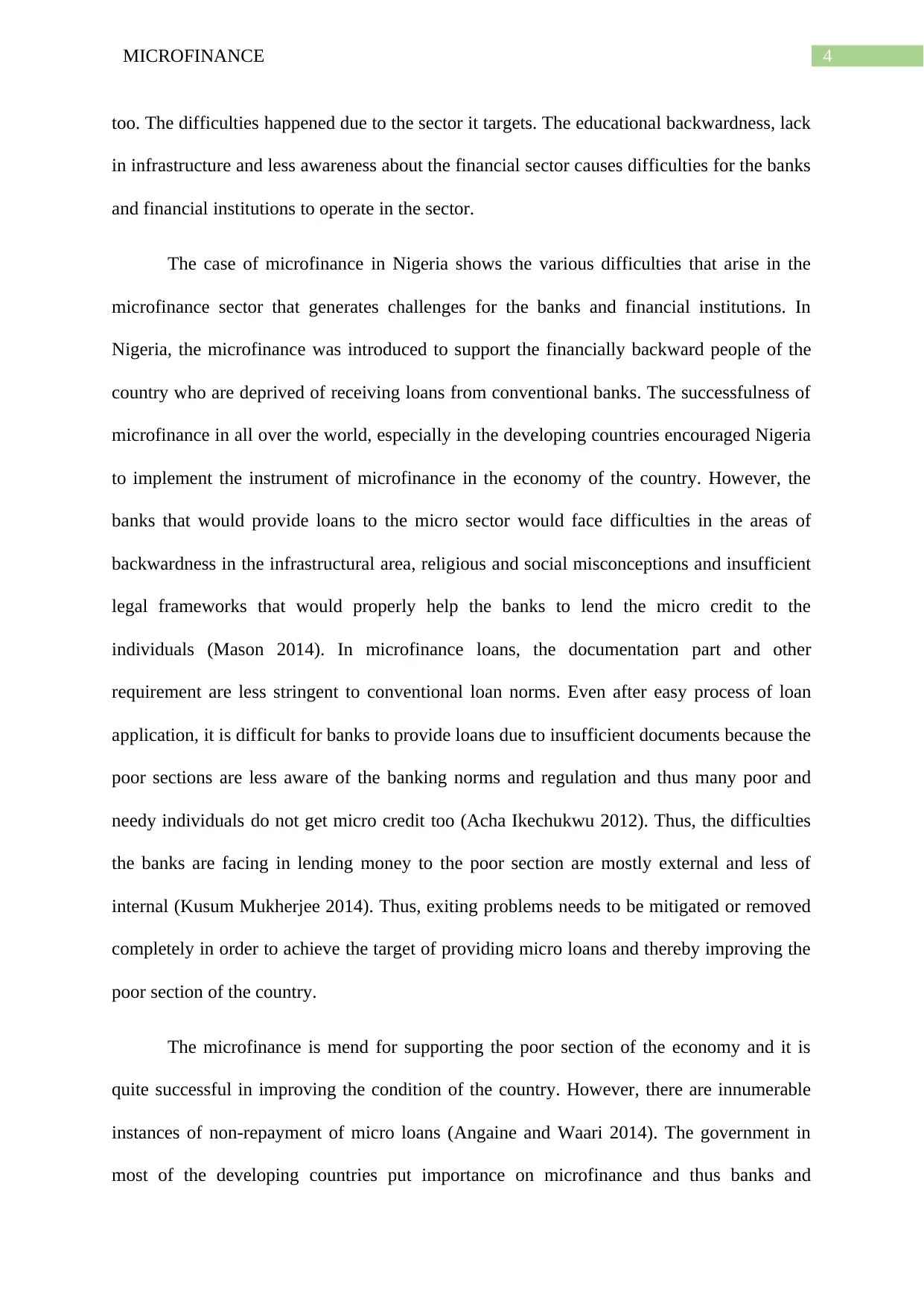
4MICROFINANCE
too. The difficulties happened due to the sector it targets. The educational backwardness, lack
in infrastructure and less awareness about the financial sector causes difficulties for the banks
and financial institutions to operate in the sector.
The case of microfinance in Nigeria shows the various difficulties that arise in the
microfinance sector that generates challenges for the banks and financial institutions. In
Nigeria, the microfinance was introduced to support the financially backward people of the
country who are deprived of receiving loans from conventional banks. The successfulness of
microfinance in all over the world, especially in the developing countries encouraged Nigeria
to implement the instrument of microfinance in the economy of the country. However, the
banks that would provide loans to the micro sector would face difficulties in the areas of
backwardness in the infrastructural area, religious and social misconceptions and insufficient
legal frameworks that would properly help the banks to lend the micro credit to the
individuals (Mason 2014). In microfinance loans, the documentation part and other
requirement are less stringent to conventional loan norms. Even after easy process of loan
application, it is difficult for banks to provide loans due to insufficient documents because the
poor sections are less aware of the banking norms and regulation and thus many poor and
needy individuals do not get micro credit too (Acha Ikechukwu 2012). Thus, the difficulties
the banks are facing in lending money to the poor section are mostly external and less of
internal (Kusum Mukherjee 2014). Thus, exiting problems needs to be mitigated or removed
completely in order to achieve the target of providing micro loans and thereby improving the
poor section of the country.
The microfinance is mend for supporting the poor section of the economy and it is
quite successful in improving the condition of the country. However, there are innumerable
instances of non-repayment of micro loans (Angaine and Waari 2014). The government in
most of the developing countries put importance on microfinance and thus banks and
too. The difficulties happened due to the sector it targets. The educational backwardness, lack
in infrastructure and less awareness about the financial sector causes difficulties for the banks
and financial institutions to operate in the sector.
The case of microfinance in Nigeria shows the various difficulties that arise in the
microfinance sector that generates challenges for the banks and financial institutions. In
Nigeria, the microfinance was introduced to support the financially backward people of the
country who are deprived of receiving loans from conventional banks. The successfulness of
microfinance in all over the world, especially in the developing countries encouraged Nigeria
to implement the instrument of microfinance in the economy of the country. However, the
banks that would provide loans to the micro sector would face difficulties in the areas of
backwardness in the infrastructural area, religious and social misconceptions and insufficient
legal frameworks that would properly help the banks to lend the micro credit to the
individuals (Mason 2014). In microfinance loans, the documentation part and other
requirement are less stringent to conventional loan norms. Even after easy process of loan
application, it is difficult for banks to provide loans due to insufficient documents because the
poor sections are less aware of the banking norms and regulation and thus many poor and
needy individuals do not get micro credit too (Acha Ikechukwu 2012). Thus, the difficulties
the banks are facing in lending money to the poor section are mostly external and less of
internal (Kusum Mukherjee 2014). Thus, exiting problems needs to be mitigated or removed
completely in order to achieve the target of providing micro loans and thereby improving the
poor section of the country.
The microfinance is mend for supporting the poor section of the economy and it is
quite successful in improving the condition of the country. However, there are innumerable
instances of non-repayment of micro loans (Angaine and Waari 2014). The government in
most of the developing countries put importance on microfinance and thus banks and
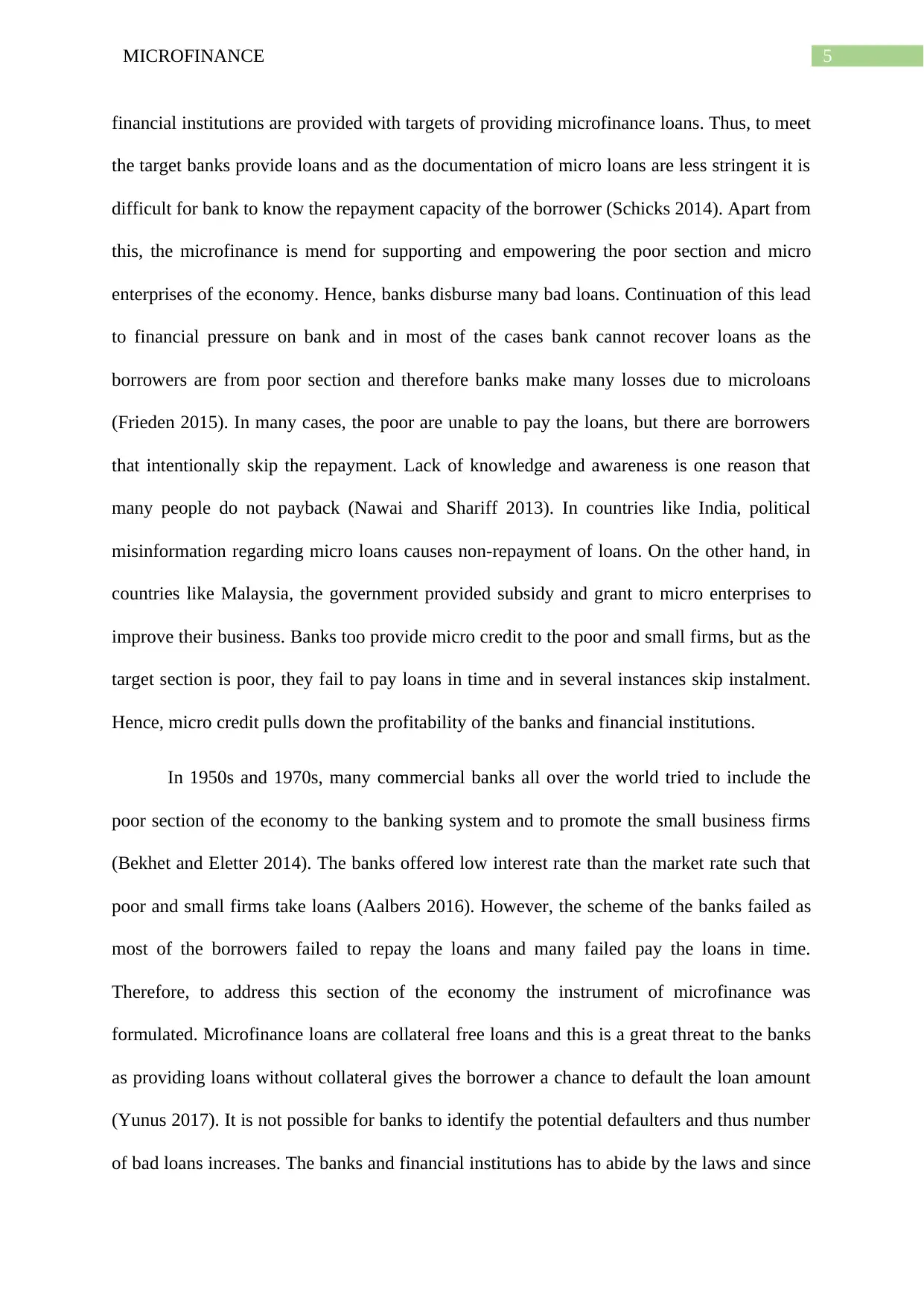
5MICROFINANCE
financial institutions are provided with targets of providing microfinance loans. Thus, to meet
the target banks provide loans and as the documentation of micro loans are less stringent it is
difficult for bank to know the repayment capacity of the borrower (Schicks 2014). Apart from
this, the microfinance is mend for supporting and empowering the poor section and micro
enterprises of the economy. Hence, banks disburse many bad loans. Continuation of this lead
to financial pressure on bank and in most of the cases bank cannot recover loans as the
borrowers are from poor section and therefore banks make many losses due to microloans
(Frieden 2015). In many cases, the poor are unable to pay the loans, but there are borrowers
that intentionally skip the repayment. Lack of knowledge and awareness is one reason that
many people do not payback (Nawai and Shariff 2013). In countries like India, political
misinformation regarding micro loans causes non-repayment of loans. On the other hand, in
countries like Malaysia, the government provided subsidy and grant to micro enterprises to
improve their business. Banks too provide micro credit to the poor and small firms, but as the
target section is poor, they fail to pay loans in time and in several instances skip instalment.
Hence, micro credit pulls down the profitability of the banks and financial institutions.
In 1950s and 1970s, many commercial banks all over the world tried to include the
poor section of the economy to the banking system and to promote the small business firms
(Bekhet and Eletter 2014). The banks offered low interest rate than the market rate such that
poor and small firms take loans (Aalbers 2016). However, the scheme of the banks failed as
most of the borrowers failed to repay the loans and many failed pay the loans in time.
Therefore, to address this section of the economy the instrument of microfinance was
formulated. Microfinance loans are collateral free loans and this is a great threat to the banks
as providing loans without collateral gives the borrower a chance to default the loan amount
(Yunus 2017). It is not possible for banks to identify the potential defaulters and thus number
of bad loans increases. The banks and financial institutions has to abide by the laws and since
financial institutions are provided with targets of providing microfinance loans. Thus, to meet
the target banks provide loans and as the documentation of micro loans are less stringent it is
difficult for bank to know the repayment capacity of the borrower (Schicks 2014). Apart from
this, the microfinance is mend for supporting and empowering the poor section and micro
enterprises of the economy. Hence, banks disburse many bad loans. Continuation of this lead
to financial pressure on bank and in most of the cases bank cannot recover loans as the
borrowers are from poor section and therefore banks make many losses due to microloans
(Frieden 2015). In many cases, the poor are unable to pay the loans, but there are borrowers
that intentionally skip the repayment. Lack of knowledge and awareness is one reason that
many people do not payback (Nawai and Shariff 2013). In countries like India, political
misinformation regarding micro loans causes non-repayment of loans. On the other hand, in
countries like Malaysia, the government provided subsidy and grant to micro enterprises to
improve their business. Banks too provide micro credit to the poor and small firms, but as the
target section is poor, they fail to pay loans in time and in several instances skip instalment.
Hence, micro credit pulls down the profitability of the banks and financial institutions.
In 1950s and 1970s, many commercial banks all over the world tried to include the
poor section of the economy to the banking system and to promote the small business firms
(Bekhet and Eletter 2014). The banks offered low interest rate than the market rate such that
poor and small firms take loans (Aalbers 2016). However, the scheme of the banks failed as
most of the borrowers failed to repay the loans and many failed pay the loans in time.
Therefore, to address this section of the economy the instrument of microfinance was
formulated. Microfinance loans are collateral free loans and this is a great threat to the banks
as providing loans without collateral gives the borrower a chance to default the loan amount
(Yunus 2017). It is not possible for banks to identify the potential defaulters and thus number
of bad loans increases. The banks and financial institutions has to abide by the laws and since
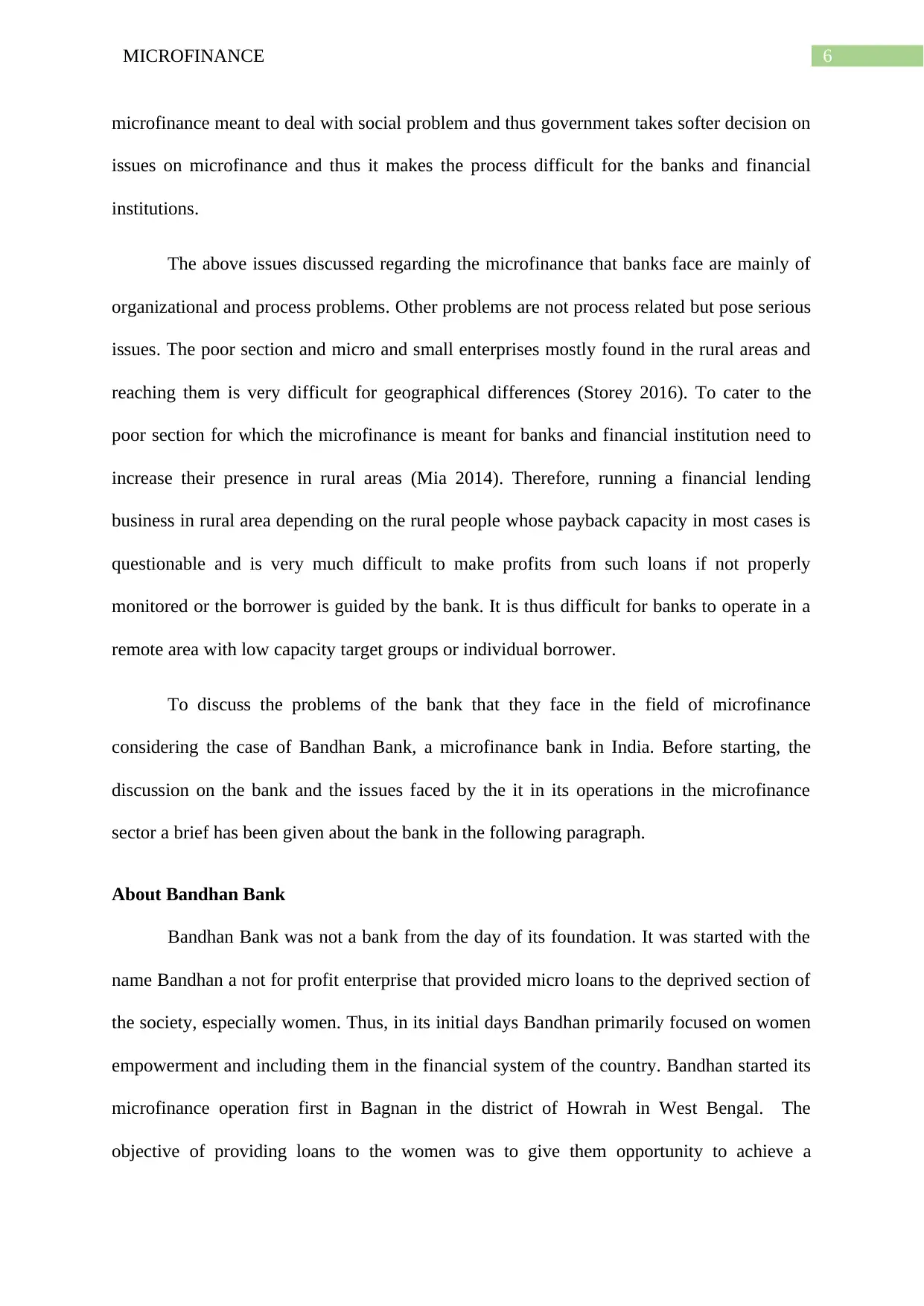
6MICROFINANCE
microfinance meant to deal with social problem and thus government takes softer decision on
issues on microfinance and thus it makes the process difficult for the banks and financial
institutions.
The above issues discussed regarding the microfinance that banks face are mainly of
organizational and process problems. Other problems are not process related but pose serious
issues. The poor section and micro and small enterprises mostly found in the rural areas and
reaching them is very difficult for geographical differences (Storey 2016). To cater to the
poor section for which the microfinance is meant for banks and financial institution need to
increase their presence in rural areas (Mia 2014). Therefore, running a financial lending
business in rural area depending on the rural people whose payback capacity in most cases is
questionable and is very much difficult to make profits from such loans if not properly
monitored or the borrower is guided by the bank. It is thus difficult for banks to operate in a
remote area with low capacity target groups or individual borrower.
To discuss the problems of the bank that they face in the field of microfinance
considering the case of Bandhan Bank, a microfinance bank in India. Before starting, the
discussion on the bank and the issues faced by the it in its operations in the microfinance
sector a brief has been given about the bank in the following paragraph.
About Bandhan Bank
Bandhan Bank was not a bank from the day of its foundation. It was started with the
name Bandhan a not for profit enterprise that provided micro loans to the deprived section of
the society, especially women. Thus, in its initial days Bandhan primarily focused on women
empowerment and including them in the financial system of the country. Bandhan started its
microfinance operation first in Bagnan in the district of Howrah in West Bengal. The
objective of providing loans to the women was to give them opportunity to achieve a
microfinance meant to deal with social problem and thus government takes softer decision on
issues on microfinance and thus it makes the process difficult for the banks and financial
institutions.
The above issues discussed regarding the microfinance that banks face are mainly of
organizational and process problems. Other problems are not process related but pose serious
issues. The poor section and micro and small enterprises mostly found in the rural areas and
reaching them is very difficult for geographical differences (Storey 2016). To cater to the
poor section for which the microfinance is meant for banks and financial institution need to
increase their presence in rural areas (Mia 2014). Therefore, running a financial lending
business in rural area depending on the rural people whose payback capacity in most cases is
questionable and is very much difficult to make profits from such loans if not properly
monitored or the borrower is guided by the bank. It is thus difficult for banks to operate in a
remote area with low capacity target groups or individual borrower.
To discuss the problems of the bank that they face in the field of microfinance
considering the case of Bandhan Bank, a microfinance bank in India. Before starting, the
discussion on the bank and the issues faced by the it in its operations in the microfinance
sector a brief has been given about the bank in the following paragraph.
About Bandhan Bank
Bandhan Bank was not a bank from the day of its foundation. It was started with the
name Bandhan a not for profit enterprise that provided micro loans to the deprived section of
the society, especially women. Thus, in its initial days Bandhan primarily focused on women
empowerment and including them in the financial system of the country. Bandhan started its
microfinance operation first in Bagnan in the district of Howrah in West Bengal. The
objective of providing loans to the women was to give them opportunity to achieve a
Paraphrase This Document
Need a fresh take? Get an instant paraphrase of this document with our AI Paraphraser

7MICROFINANCE
sustainable and prospective livelihood. Later, to extend its operation in the field of
microfinance it made an acquisition of a Non-Banking Financial Corporation (NBFC) in
2006. After acquisition it modified in to a NBFC Microfinance Institution to strengthen and
focus on its basic objective of financial inclusion. The first achievement of Bandhan was in
2010, when the Government of India recognised it as the largest Microfinance Institution in
the country. Bandhan got the approval for establishing a universal bank in 2014 and in 17th
June and on December 23 2014 it was incorporated as Bandhan Bank Limited the largest
microfinance organization in India. It is the subsidiary of Bandhan Financials Holdings
Limited (Bandhanbank.com 2019). The next year the Reserve Bank of India provided the
licence of bank to Bandhan, since that day Bandhan is known as Bandhan Bank. From 23rd
August 2015, Bandhan Bank started operation and is now one of the successful banks that
focus in the micro credit sector. It also holds the record of the first bank that has been
established in the Eastern India after independence. International Finance Corporation, Small
Industries Development Bank of India, FIG Investment Company, Caladium Investment Pte.
Ltd. and the Sovereign Wealth Fund of Singapore are major among its public sector
shareholders. Bandhan Bank became a stock market listed bank on 27th March, 201* and as
per market capital it is then the 8th largest bank in India. The slogan of the bank is “Aapka
Bhala, Sabki Bhalai”. The bank started its operation with, fifty ATMs, 501 branches and
2022 Doorstep Service Centres. Currently, the bank has 999 branches, 481 ATMs and 3014
Doorstep Service Centres. It has a customer base of 1.65 crores. The total number of
employees of Bnadhan Bank is 32342 on direct payroll of the bank. So far, the bank has
rotated more than Rs. 43,232 crore of deposits and it has total advances of Rs. 44,776 crore.
Issues in the Bank
Bandhan Bank the largest Microfinance Institution of India has been doing good in
the sector it operates until 2018. In 2018, the bank failed to bring down the Non Operative
sustainable and prospective livelihood. Later, to extend its operation in the field of
microfinance it made an acquisition of a Non-Banking Financial Corporation (NBFC) in
2006. After acquisition it modified in to a NBFC Microfinance Institution to strengthen and
focus on its basic objective of financial inclusion. The first achievement of Bandhan was in
2010, when the Government of India recognised it as the largest Microfinance Institution in
the country. Bandhan got the approval for establishing a universal bank in 2014 and in 17th
June and on December 23 2014 it was incorporated as Bandhan Bank Limited the largest
microfinance organization in India. It is the subsidiary of Bandhan Financials Holdings
Limited (Bandhanbank.com 2019). The next year the Reserve Bank of India provided the
licence of bank to Bandhan, since that day Bandhan is known as Bandhan Bank. From 23rd
August 2015, Bandhan Bank started operation and is now one of the successful banks that
focus in the micro credit sector. It also holds the record of the first bank that has been
established in the Eastern India after independence. International Finance Corporation, Small
Industries Development Bank of India, FIG Investment Company, Caladium Investment Pte.
Ltd. and the Sovereign Wealth Fund of Singapore are major among its public sector
shareholders. Bandhan Bank became a stock market listed bank on 27th March, 201* and as
per market capital it is then the 8th largest bank in India. The slogan of the bank is “Aapka
Bhala, Sabki Bhalai”. The bank started its operation with, fifty ATMs, 501 branches and
2022 Doorstep Service Centres. Currently, the bank has 999 branches, 481 ATMs and 3014
Doorstep Service Centres. It has a customer base of 1.65 crores. The total number of
employees of Bnadhan Bank is 32342 on direct payroll of the bank. So far, the bank has
rotated more than Rs. 43,232 crore of deposits and it has total advances of Rs. 44,776 crore.
Issues in the Bank
Bandhan Bank the largest Microfinance Institution of India has been doing good in
the sector it operates until 2018. In 2018, the bank failed to bring down the Non Operative

8MICROFINANCE
Financial Holding Company’s shareholding percentage to 40 as per the guidelines of the
Reserve Bank of India’s licencing policy. Consequently, the Reserve Bank of India has
restricted the Bank from opening new branches. As per the order of the Reserve Bank of
India, the salary of the CEO of Bandhan Bank was also put on hold due to the issues
mentioned above (The Economic Times 2018). The consequence of not complying with the
rules and regulations of the shareholding licence was not limited to the order made by the
Reserve Bank of India. Owing to this failure in maintaining the shareholding regulations, the
stock of the bank fell by 20 per cent. However, there is scope of opening new branches only
if permission is granted to the bank by the Reserve Bank of India. Apart from this, there is
another problem the bank is facing and is the over infusion of money in the bank in the form
of deposit. The money in the bank that infused in the form of deposit requires time to deploy
in the market by lending. The process of lending is much lengthy than the process of
deposition of money. Thus, deploying deposited money in the economy takes time and as a
result the volume of deposited money gets increased and capital adequacy ratio of the bank
increase and hit the point as high as 32 percent, which is higher than the capital adequacy
ratio of the State Bank of India.
Microfinance products and services provided in the bank
Bandhan Bank after it started operating as a bank offers various kind of products
including personal loan, home loan and many more but its main objective is to provide loans
to the micro sector. Thus, it has four major products that cater to the micro sector, and the
products are micro, small and medium enterprise loan, small enterprise loan, micro loan and
agri loan. Under micro, small and medium enterprise loan the bank offers working capital
loan and term loan. Working capital loan is to support the MSMEs in order to make them
able to run their business smoothly by providing the amount of liquidity they need keep their
production process going. The term loan is provided to enhance the fixed assets of the micro
Financial Holding Company’s shareholding percentage to 40 as per the guidelines of the
Reserve Bank of India’s licencing policy. Consequently, the Reserve Bank of India has
restricted the Bank from opening new branches. As per the order of the Reserve Bank of
India, the salary of the CEO of Bandhan Bank was also put on hold due to the issues
mentioned above (The Economic Times 2018). The consequence of not complying with the
rules and regulations of the shareholding licence was not limited to the order made by the
Reserve Bank of India. Owing to this failure in maintaining the shareholding regulations, the
stock of the bank fell by 20 per cent. However, there is scope of opening new branches only
if permission is granted to the bank by the Reserve Bank of India. Apart from this, there is
another problem the bank is facing and is the over infusion of money in the bank in the form
of deposit. The money in the bank that infused in the form of deposit requires time to deploy
in the market by lending. The process of lending is much lengthy than the process of
deposition of money. Thus, deploying deposited money in the economy takes time and as a
result the volume of deposited money gets increased and capital adequacy ratio of the bank
increase and hit the point as high as 32 percent, which is higher than the capital adequacy
ratio of the State Bank of India.
Microfinance products and services provided in the bank
Bandhan Bank after it started operating as a bank offers various kind of products
including personal loan, home loan and many more but its main objective is to provide loans
to the micro sector. Thus, it has four major products that cater to the micro sector, and the
products are micro, small and medium enterprise loan, small enterprise loan, micro loan and
agri loan. Under micro, small and medium enterprise loan the bank offers working capital
loan and term loan. Working capital loan is to support the MSMEs in order to make them
able to run their business smoothly by providing the amount of liquidity they need keep their
production process going. The term loan is provided to enhance the fixed assets of the micro

9MICROFINANCE
production unit to scale up the productivity by adding new machine or technology. Under
small enterprise loan, the bank offers collateral free loans to the firms in order to support the
firm to purchase assets and raw materials or working capital. This product is mainly for the
small firms that require both working capital and term loans. Micro loan that the bank offers
can be termed as the product of empowerment as it provide loans to new aspirant or
entrepreneur, especially women. There are four kinds of micro loans, and are Suchana,
Srishti, Suraksha and Susiksha. Suchana target the new women entrepreneurs and Suraksha is
for emergency medical needs. Srishti is for expansion of existing units by adding up working
capital, new assets to the production process and hiring new employees and Susiksha is for
the educational needs of the children of the existing micro loan customers of the banks such
that the children can continue their study without any interruption (Bandhanbank.com 2019).
Apart from the microfinance-oriented loans, it offers agricultural loan in the form of Kisan
Credit Card to help the farmers with working capital and investments in livestock, farm,
warehouse and plant. Therefore, the above mentioned loans are major microfinance loans that
the banks provide to support the MSMEs and thereby try to achieve their objective of
developing micro sector. However, the loans attract high interest rate that in many cases
creates difficulty for the micro borrowers (Mersland and Strøm 2016). The micro loans that
are meant for medical and education purpose are the only exception in terms of interest rate
as they offer much lower interest rate in comparison to the other loans.
Conclusion
The topic of microfinance has always been a centre of debate from the date of its
introduction in the financial sector. The conceptualization of microfinance was made to
address the poor section of the economy because the conventional process of lending could
not solve the problem and financial need of poor individuals and business. After the
introduction of microfinance in 1970s in Bangladesh, many other developing and developed
production unit to scale up the productivity by adding new machine or technology. Under
small enterprise loan, the bank offers collateral free loans to the firms in order to support the
firm to purchase assets and raw materials or working capital. This product is mainly for the
small firms that require both working capital and term loans. Micro loan that the bank offers
can be termed as the product of empowerment as it provide loans to new aspirant or
entrepreneur, especially women. There are four kinds of micro loans, and are Suchana,
Srishti, Suraksha and Susiksha. Suchana target the new women entrepreneurs and Suraksha is
for emergency medical needs. Srishti is for expansion of existing units by adding up working
capital, new assets to the production process and hiring new employees and Susiksha is for
the educational needs of the children of the existing micro loan customers of the banks such
that the children can continue their study without any interruption (Bandhanbank.com 2019).
Apart from the microfinance-oriented loans, it offers agricultural loan in the form of Kisan
Credit Card to help the farmers with working capital and investments in livestock, farm,
warehouse and plant. Therefore, the above mentioned loans are major microfinance loans that
the banks provide to support the MSMEs and thereby try to achieve their objective of
developing micro sector. However, the loans attract high interest rate that in many cases
creates difficulty for the micro borrowers (Mersland and Strøm 2016). The micro loans that
are meant for medical and education purpose are the only exception in terms of interest rate
as they offer much lower interest rate in comparison to the other loans.
Conclusion
The topic of microfinance has always been a centre of debate from the date of its
introduction in the financial sector. The conceptualization of microfinance was made to
address the poor section of the economy because the conventional process of lending could
not solve the problem and financial need of poor individuals and business. After the
introduction of microfinance in 1970s in Bangladesh, many other developing and developed
Secure Best Marks with AI Grader
Need help grading? Try our AI Grader for instant feedback on your assignments.

10MICROFINANCE
countries adopted the micro lending process and extended benefit to the needy section of the
economy. Moreover, every idea comes with advantages and disadvantages of its own and
microfinance is no exception because extending microfinance requires infrastructure,
technology and many other financial aspects, but in rural area, it is difficult to avail
everything it requires to run the process smoothly. Thus, the banks and financial institution
that extend loans to this sector face various difficulties in the process of providing loans. In
India, Bandhan bank is the largest MFI that extends financial support to the micro sector
through various micro loan products. In recent years, the bank faced few downturns due to
not complying with the Reserve Bank of India’s guideline of shareholding percentage.
However, at present the bank has recovered from the adverse condition and operating
smoothly.
Recommendation
The microfinance sector faces many issues in terms of extending loans to the needy
section that get avoided due to infrastructural backwardness, in ability to identify potential
defaulters, misuse of collateral free loans and high interest rate. To address these issue the
banks and MFIs need to make their presence in the innermost part of the rural areas and for
this they can hire employees from the area it is willing to open branch as this will enable the
bank to connect with the root of the area it is catering. This will solve the problem of misuse
of collateral free loans too; however, bank should create some stake for the borrowers in the
case of collateral free loans to avoid defaults. The high interest charged by the MFIs
discourages many potential micro entrepreneurs from taking micro loans (Kaur 2016). Thus,
to attract such customers bank can include flexible interest rate system to its lending policy.
countries adopted the micro lending process and extended benefit to the needy section of the
economy. Moreover, every idea comes with advantages and disadvantages of its own and
microfinance is no exception because extending microfinance requires infrastructure,
technology and many other financial aspects, but in rural area, it is difficult to avail
everything it requires to run the process smoothly. Thus, the banks and financial institution
that extend loans to this sector face various difficulties in the process of providing loans. In
India, Bandhan bank is the largest MFI that extends financial support to the micro sector
through various micro loan products. In recent years, the bank faced few downturns due to
not complying with the Reserve Bank of India’s guideline of shareholding percentage.
However, at present the bank has recovered from the adverse condition and operating
smoothly.
Recommendation
The microfinance sector faces many issues in terms of extending loans to the needy
section that get avoided due to infrastructural backwardness, in ability to identify potential
defaulters, misuse of collateral free loans and high interest rate. To address these issue the
banks and MFIs need to make their presence in the innermost part of the rural areas and for
this they can hire employees from the area it is willing to open branch as this will enable the
bank to connect with the root of the area it is catering. This will solve the problem of misuse
of collateral free loans too; however, bank should create some stake for the borrowers in the
case of collateral free loans to avoid defaults. The high interest charged by the MFIs
discourages many potential micro entrepreneurs from taking micro loans (Kaur 2016). Thus,
to attract such customers bank can include flexible interest rate system to its lending policy.
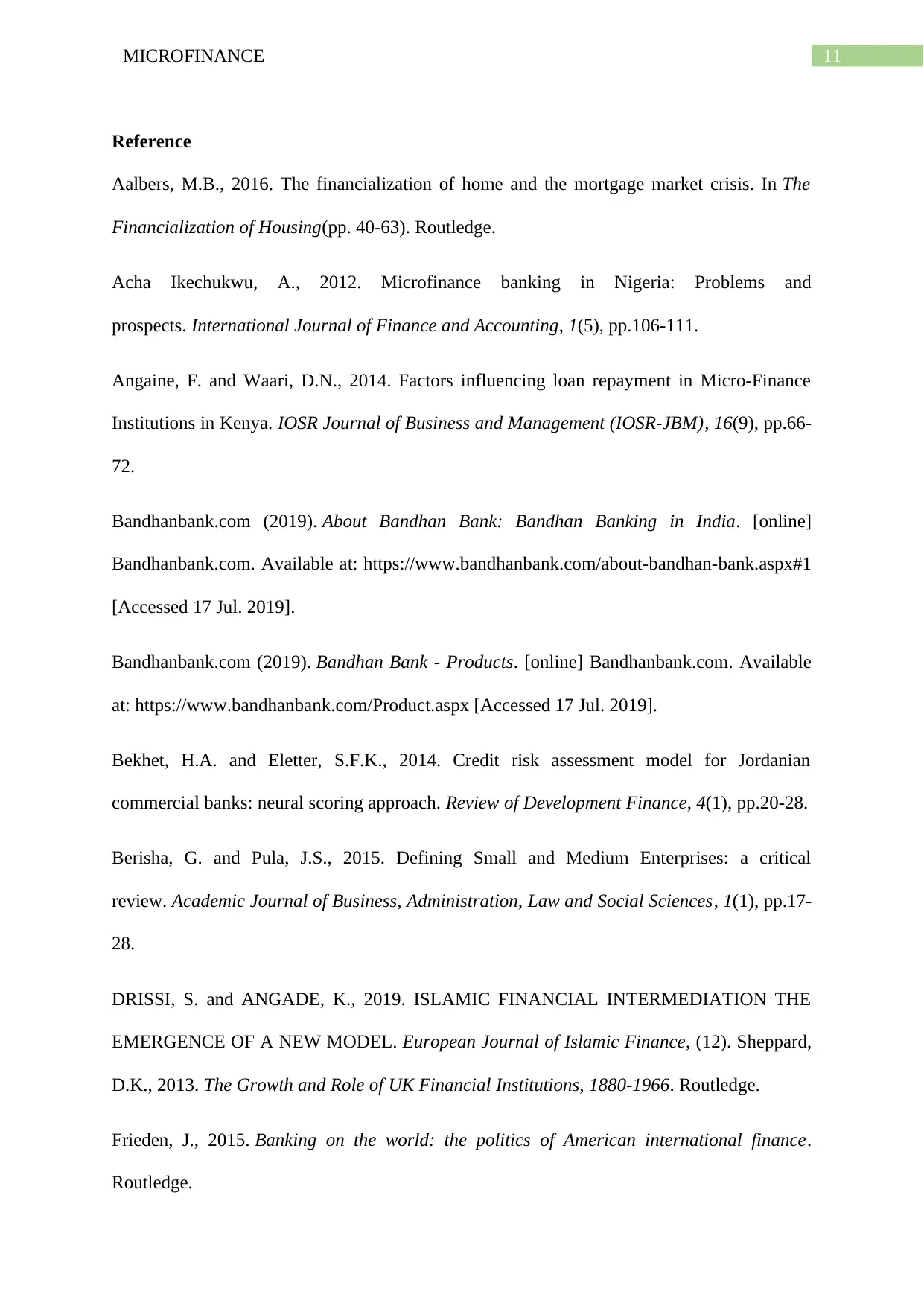
11MICROFINANCE
Reference
Aalbers, M.B., 2016. The financialization of home and the mortgage market crisis. In The
Financialization of Housing(pp. 40-63). Routledge.
Acha Ikechukwu, A., 2012. Microfinance banking in Nigeria: Problems and
prospects. International Journal of Finance and Accounting, 1(5), pp.106-111.
Angaine, F. and Waari, D.N., 2014. Factors influencing loan repayment in Micro-Finance
Institutions in Kenya. IOSR Journal of Business and Management (IOSR-JBM), 16(9), pp.66-
72.
Bandhanbank.com (2019). About Bandhan Bank: Bandhan Banking in India. [online]
Bandhanbank.com. Available at: https://www.bandhanbank.com/about-bandhan-bank.aspx#1
[Accessed 17 Jul. 2019].
Bandhanbank.com (2019). Bandhan Bank - Products. [online] Bandhanbank.com. Available
at: https://www.bandhanbank.com/Product.aspx [Accessed 17 Jul. 2019].
Bekhet, H.A. and Eletter, S.F.K., 2014. Credit risk assessment model for Jordanian
commercial banks: neural scoring approach. Review of Development Finance, 4(1), pp.20-28.
Berisha, G. and Pula, J.S., 2015. Defining Small and Medium Enterprises: a critical
review. Academic Journal of Business, Administration, Law and Social Sciences, 1(1), pp.17-
28.
DRISSI, S. and ANGADE, K., 2019. ISLAMIC FINANCIAL INTERMEDIATION THE
EMERGENCE OF A NEW MODEL. European Journal of Islamic Finance, (12). Sheppard,
D.K., 2013. The Growth and Role of UK Financial Institutions, 1880-1966. Routledge.
Frieden, J., 2015. Banking on the world: the politics of American international finance.
Routledge.
Reference
Aalbers, M.B., 2016. The financialization of home and the mortgage market crisis. In The
Financialization of Housing(pp. 40-63). Routledge.
Acha Ikechukwu, A., 2012. Microfinance banking in Nigeria: Problems and
prospects. International Journal of Finance and Accounting, 1(5), pp.106-111.
Angaine, F. and Waari, D.N., 2014. Factors influencing loan repayment in Micro-Finance
Institutions in Kenya. IOSR Journal of Business and Management (IOSR-JBM), 16(9), pp.66-
72.
Bandhanbank.com (2019). About Bandhan Bank: Bandhan Banking in India. [online]
Bandhanbank.com. Available at: https://www.bandhanbank.com/about-bandhan-bank.aspx#1
[Accessed 17 Jul. 2019].
Bandhanbank.com (2019). Bandhan Bank - Products. [online] Bandhanbank.com. Available
at: https://www.bandhanbank.com/Product.aspx [Accessed 17 Jul. 2019].
Bekhet, H.A. and Eletter, S.F.K., 2014. Credit risk assessment model for Jordanian
commercial banks: neural scoring approach. Review of Development Finance, 4(1), pp.20-28.
Berisha, G. and Pula, J.S., 2015. Defining Small and Medium Enterprises: a critical
review. Academic Journal of Business, Administration, Law and Social Sciences, 1(1), pp.17-
28.
DRISSI, S. and ANGADE, K., 2019. ISLAMIC FINANCIAL INTERMEDIATION THE
EMERGENCE OF A NEW MODEL. European Journal of Islamic Finance, (12). Sheppard,
D.K., 2013. The Growth and Role of UK Financial Institutions, 1880-1966. Routledge.
Frieden, J., 2015. Banking on the world: the politics of American international finance.
Routledge.
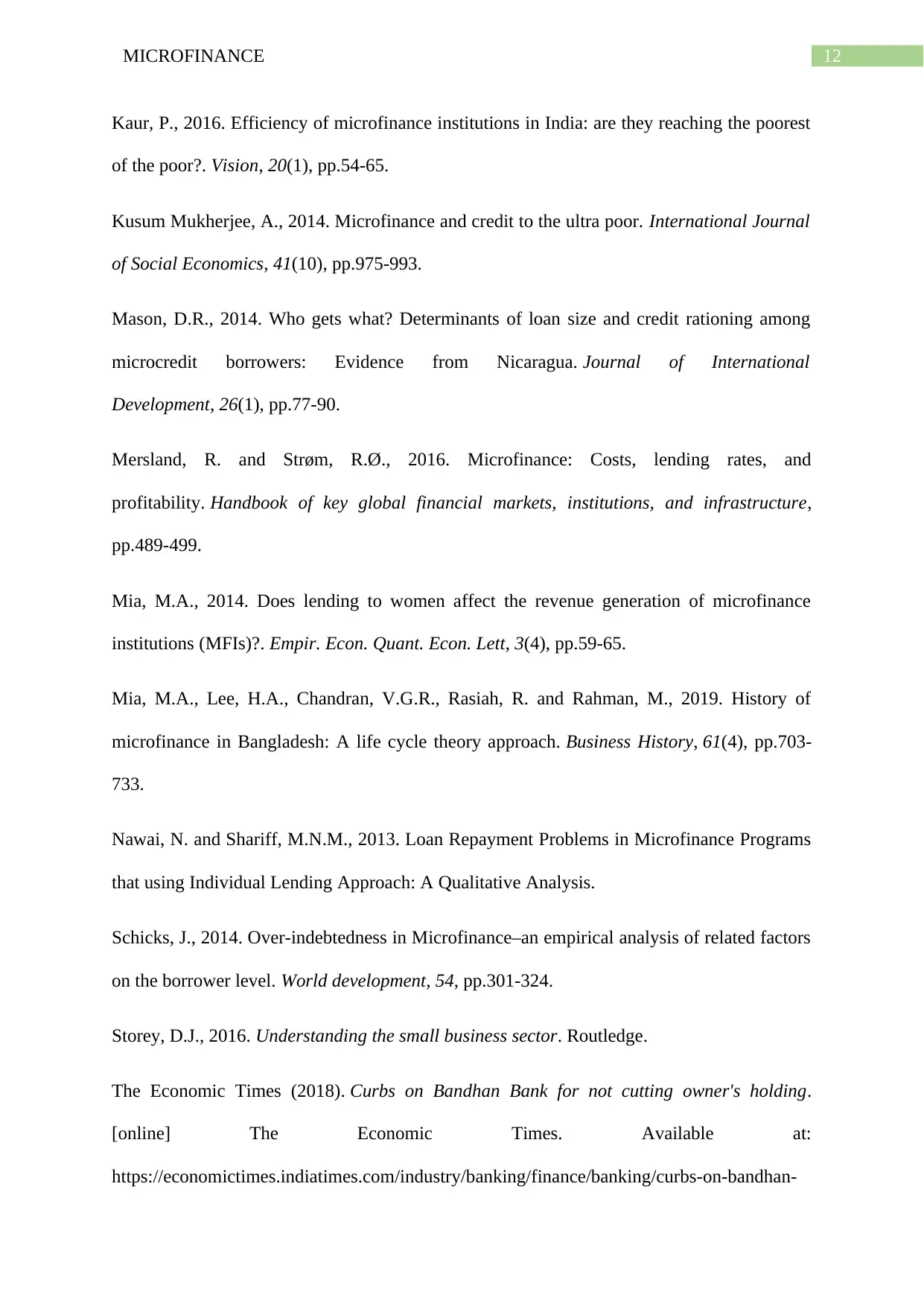
12MICROFINANCE
Kaur, P., 2016. Efficiency of microfinance institutions in India: are they reaching the poorest
of the poor?. Vision, 20(1), pp.54-65.
Kusum Mukherjee, A., 2014. Microfinance and credit to the ultra poor. International Journal
of Social Economics, 41(10), pp.975-993.
Mason, D.R., 2014. Who gets what? Determinants of loan size and credit rationing among
microcredit borrowers: Evidence from Nicaragua. Journal of International
Development, 26(1), pp.77-90.
Mersland, R. and Strøm, R.Ø., 2016. Microfinance: Costs, lending rates, and
profitability. Handbook of key global financial markets, institutions, and infrastructure,
pp.489-499.
Mia, M.A., 2014. Does lending to women affect the revenue generation of microfinance
institutions (MFIs)?. Empir. Econ. Quant. Econ. Lett, 3(4), pp.59-65.
Mia, M.A., Lee, H.A., Chandran, V.G.R., Rasiah, R. and Rahman, M., 2019. History of
microfinance in Bangladesh: A life cycle theory approach. Business History, 61(4), pp.703-
733.
Nawai, N. and Shariff, M.N.M., 2013. Loan Repayment Problems in Microfinance Programs
that using Individual Lending Approach: A Qualitative Analysis.
Schicks, J., 2014. Over-indebtedness in Microfinance–an empirical analysis of related factors
on the borrower level. World development, 54, pp.301-324.
Storey, D.J., 2016. Understanding the small business sector. Routledge.
The Economic Times (2018). Curbs on Bandhan Bank for not cutting owner's holding.
[online] The Economic Times. Available at:
https://economictimes.indiatimes.com/industry/banking/finance/banking/curbs-on-bandhan-
Kaur, P., 2016. Efficiency of microfinance institutions in India: are they reaching the poorest
of the poor?. Vision, 20(1), pp.54-65.
Kusum Mukherjee, A., 2014. Microfinance and credit to the ultra poor. International Journal
of Social Economics, 41(10), pp.975-993.
Mason, D.R., 2014. Who gets what? Determinants of loan size and credit rationing among
microcredit borrowers: Evidence from Nicaragua. Journal of International
Development, 26(1), pp.77-90.
Mersland, R. and Strøm, R.Ø., 2016. Microfinance: Costs, lending rates, and
profitability. Handbook of key global financial markets, institutions, and infrastructure,
pp.489-499.
Mia, M.A., 2014. Does lending to women affect the revenue generation of microfinance
institutions (MFIs)?. Empir. Econ. Quant. Econ. Lett, 3(4), pp.59-65.
Mia, M.A., Lee, H.A., Chandran, V.G.R., Rasiah, R. and Rahman, M., 2019. History of
microfinance in Bangladesh: A life cycle theory approach. Business History, 61(4), pp.703-
733.
Nawai, N. and Shariff, M.N.M., 2013. Loan Repayment Problems in Microfinance Programs
that using Individual Lending Approach: A Qualitative Analysis.
Schicks, J., 2014. Over-indebtedness in Microfinance–an empirical analysis of related factors
on the borrower level. World development, 54, pp.301-324.
Storey, D.J., 2016. Understanding the small business sector. Routledge.
The Economic Times (2018). Curbs on Bandhan Bank for not cutting owner's holding.
[online] The Economic Times. Available at:
https://economictimes.indiatimes.com/industry/banking/finance/banking/curbs-on-bandhan-
Paraphrase This Document
Need a fresh take? Get an instant paraphrase of this document with our AI Paraphraser
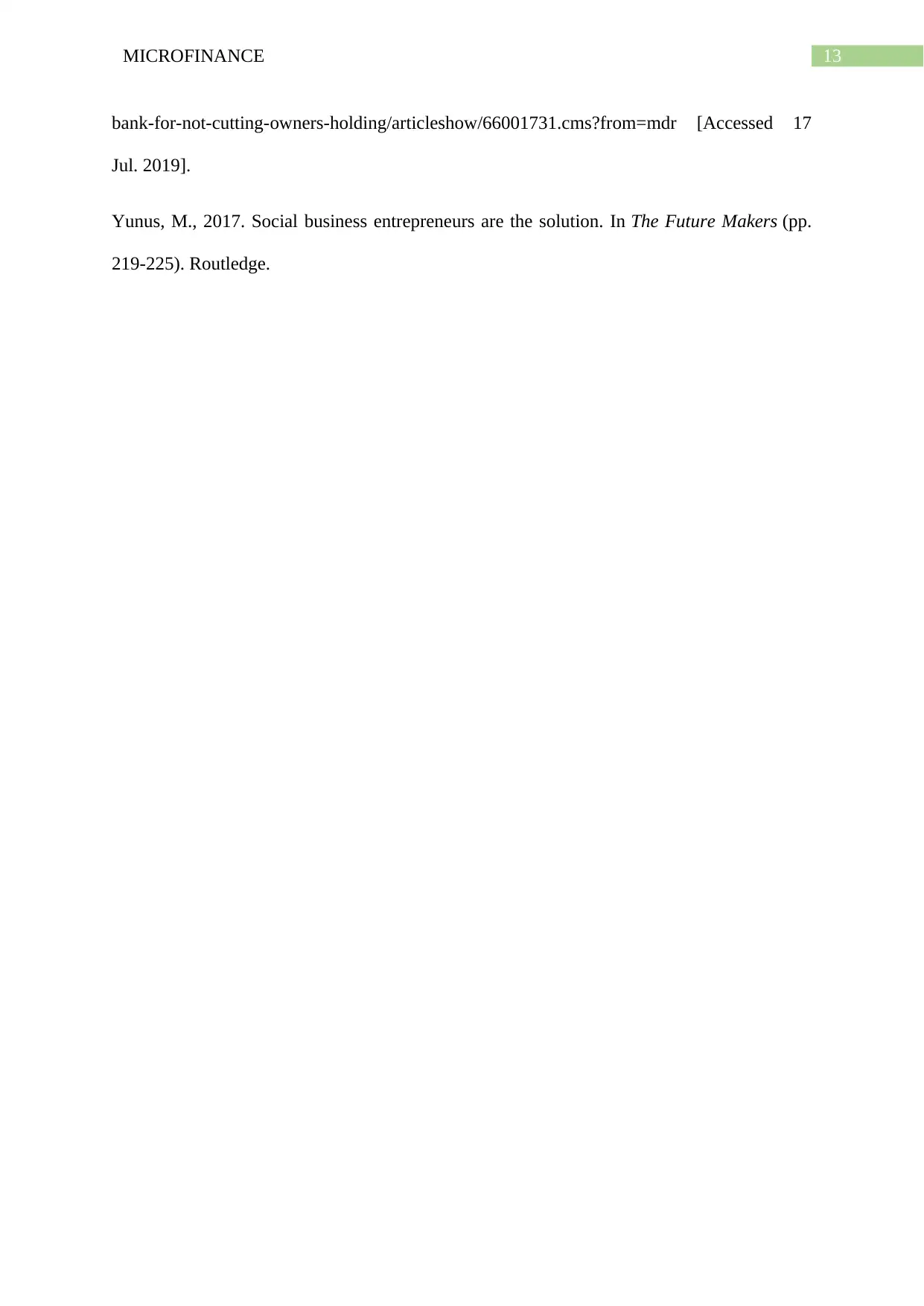
13MICROFINANCE
bank-for-not-cutting-owners-holding/articleshow/66001731.cms?from=mdr [Accessed 17
Jul. 2019].
Yunus, M., 2017. Social business entrepreneurs are the solution. In The Future Makers (pp.
219-225). Routledge.
bank-for-not-cutting-owners-holding/articleshow/66001731.cms?from=mdr [Accessed 17
Jul. 2019].
Yunus, M., 2017. Social business entrepreneurs are the solution. In The Future Makers (pp.
219-225). Routledge.
1 out of 14
Related Documents
Your All-in-One AI-Powered Toolkit for Academic Success.
+13062052269
info@desklib.com
Available 24*7 on WhatsApp / Email
![[object Object]](/_next/static/media/star-bottom.7253800d.svg)
Unlock your academic potential
© 2024 | Zucol Services PVT LTD | All rights reserved.





